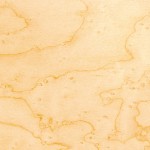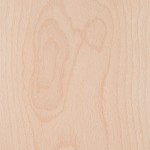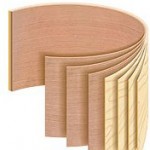
There are a few key factors that make a drum shell produce its tone. Here is a break down of what to look for in order to help you get the most bang for your buck!
What Type of Wood: The biggest factor in selecting your drum set is what type of wood the tom and bass drum shells are made of. The four most popular types of wood used for drum sets are; Maple, Birch, Beech, and Mahogany.
Each of these has distinctive sound qualities that are unique unto themselves. Let’s take a look…
 Maple: Maple is generally a popular choice for both musicians and drum companies. Maple is a beautiful wood and contains a really pleasing grain pattern which makes it a top choice when applying a stained finish to the exterior of the shell. The wide range of tones the wood can produce is a definite plus. Maple generally produces a warm tone with a substantial low end range.
Maple: Maple is generally a popular choice for both musicians and drum companies. Maple is a beautiful wood and contains a really pleasing grain pattern which makes it a top choice when applying a stained finish to the exterior of the shell. The wide range of tones the wood can produce is a definite plus. Maple generally produces a warm tone with a substantial low end range.
The projection or volume maple produces is pretty good. Maple is a great choice if you are planning on playing multiple styles of music. I have 2 maple kits and I have used them on gigs where I was playing jazz with brushes, to modern rock and funk. They hold there own in each of these settings. A little side note; my maple kits are also substantially lighter than my other kits. This is something to consider if you are going to be gigging and schlepping your own gear in and out of venues.
 Birch: Compared to maple, birch is a much denser wood. This density results in a much brighter overall tone. This creates a drum with greater attack and a shorter sustain than maple.
Birch: Compared to maple, birch is a much denser wood. This density results in a much brighter overall tone. This creates a drum with greater attack and a shorter sustain than maple.
The density also results in these shells being a bit louder than maple shells; this should be considered if they are going to be played in a live setting. All these factors combine to create shells which are well suited for heavy funk, rock, or heavy metal.
 Beech: Beech shells are generally placed between maple and birch with regard to length of sustain and tone. The resulting sound is full with a great balance of high, mid, and low tones. This wood is a bit harder and therefore louder than maple. Beech shells are not quite as versatile as maple, but can be comfortable in various musical settings.
Beech: Beech shells are generally placed between maple and birch with regard to length of sustain and tone. The resulting sound is full with a great balance of high, mid, and low tones. This wood is a bit harder and therefore louder than maple. Beech shells are not quite as versatile as maple, but can be comfortable in various musical settings.
 Mahogany: Mahogany is the softest of the four woods we are studying. This softer wood results in a 25% boost to the low end frequencies and creates mid and high tones similar to that which you would find in the maple shells. One of my custom kits gradually mixes in plies of African mahogany to the floor toms and kick drum. The low end is UH-MAZ-ING! If you are going to be playing a lot of music with quick punches or breaks, you probably want to stay away from mahogany. If you really want to “fatten up” your music, mahogany would be a great way to go. The custom kit I have with mahogany is substantially heavier than my maple kit. If you are schlepping that gear, keep this in mind.
Mahogany: Mahogany is the softest of the four woods we are studying. This softer wood results in a 25% boost to the low end frequencies and creates mid and high tones similar to that which you would find in the maple shells. One of my custom kits gradually mixes in plies of African mahogany to the floor toms and kick drum. The low end is UH-MAZ-ING! If you are going to be playing a lot of music with quick punches or breaks, you probably want to stay away from mahogany. If you really want to “fatten up” your music, mahogany would be a great way to go. The custom kit I have with mahogany is substantially heavier than my maple kit. If you are schlepping that gear, keep this in mind.
 Shell Thickness: Drum shells are commonly made of multiple thin plies rather than one solid piece. The plies are put together with thin layers of glue and formed in a steam press. Making shells from multiple layers results in increased stability and strength.
Shell Thickness: Drum shells are commonly made of multiple thin plies rather than one solid piece. The plies are put together with thin layers of glue and formed in a steam press. Making shells from multiple layers results in increased stability and strength.
The tone and pitch is greatly affected by how many plies the shell has. The basic rule of thumb is that a thicker shell produces a higher pitch and a thinner shell results in a lower pitch.
So… if “XYZ” Drum Company has two 12” x 9” toms made of the same wood, and one is 6 plies and the other 10 plies, the 6 ply shell will produce a lower tone.
A small problem exists in the industry however; this is not necessarily the case when comparing one company to another. There is no industry standard when it comes to the thickness of each ply. A denser wood can be cut to a thinner ply than the softer woods.
This means you need to factor in the overall thickness of the shell with your new found knowledge of each species of wood to help you determine which is right for you.
Leave A Reply (5 comments so far)
Gail
Wood and ply choices: one wood or a mix of different woods + ply’s- all the same in the kit or snare, base and a tom different ply’s? I have heard drums being played, where the two toms sounded too similar.
Chris
Yes. Generally speaking floor toms and kick drums will start to add a ply or two depending on what size they are. The two drums sounding the same could be due to a number of factors, but their are many different techniques to insure this doesn’t happen.
Brian H. Littleton
Wish that I had something to say intelligently on this subject, but I understand the resulting dynamics
Johnd753
I have not checked in here for a while since I thought it was getting boring, but the last few posts are good quality so I guess I’ll add you back to my daily bloglist. You deserve it my friend eekecegdedke
Blackshot Hack
I do agree with all of the concepts you have offered for your post.
They’re very convincing and can definitely work. Still, the
posts are too quick for newbies. May just you please lengthen them a little from next time?
Thanks for the post.